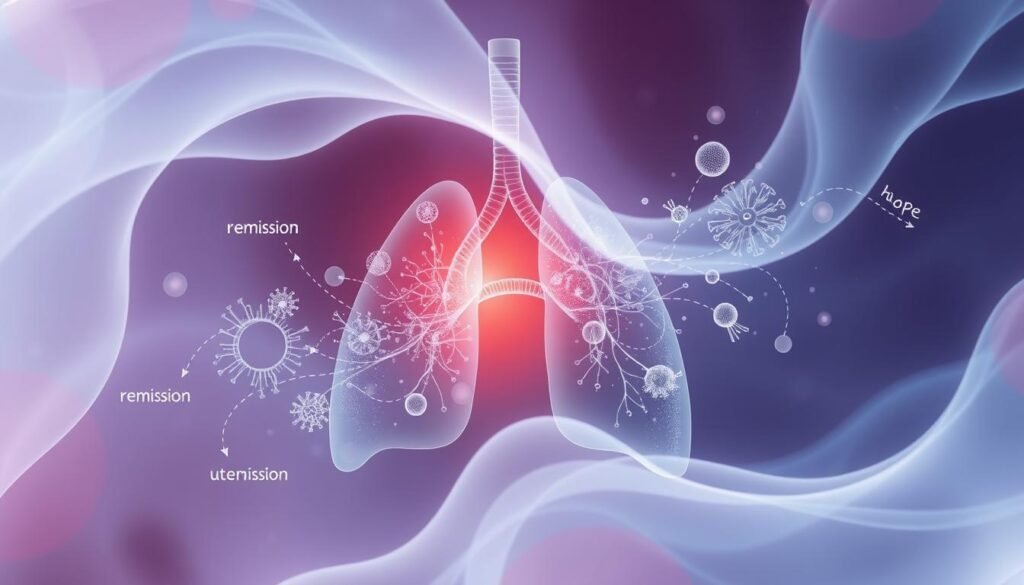Did you know small cell lung cancer (SCLC) only has a 7% five-year survival rate? This fact shows how tough this cancer can be. It often comes back within a year or two after treatment. Despite this, about 80% of people manage to reach remission at first. Knowing the signs of recovery can give hope to patients and their families during this hard time.
Dealing with SCLC remission touches both the mind and body. It affects a person’s health deeply. Knowing hopeful signs and what affects recovery is powerful. It helps patients handle their treatment and changes in life better. As we look into SCLC remission, focusing on recovery signs and guarding against comeback is crucial. It ensures care looks at all aspects of health. For deeper understanding, check the full discussion at how long small cell lung cancer stays in remission.
Key Takeaways
- Understanding small cell lung cancer remission involves recognizing specific signs of recovery.
- The survival rate for small cell lung cancer is alarmingly low, emphasizing the importance of effective treatment.
- Many patients experience recurrence of SCLC within a short time post-remission.
- Early intervention and continuous monitoring are key in managing small cell lung cancer effectively.
- The emotional journey during remission can significantly affect overall health and quality of life.
- There are hopeful signs of remission that patients should be aware of as part of their recovery process.
Understanding Small Cell Lung Cancer
Small cell lung cancer (SCLC) is a major part of lung cancer, unique in how it acts. This aggressive type of cancer is mostly found in smokers. It grows quickly. Most people find out they have it after they start showing strong symptoms. By this time, the cancer has usually spread a lot.
Definition and Characteristics
There are two main stages of small cell lung cancer: limited and extensive. In the limited stage, cancer hasn’t moved beyond one lung and its nearby lymph nodes. The extensive stage means cancer has spread to the other lung or far parts of the body. Common signs are a constant cough, difficulty breathing, chest pain, and losing weight without trying. Because it spreads fast, it’s crucial to catch and treat it early.
Statistics on Incidence and Risks
About 15% of all lung cancer cases in the US are small cell lung cancer. The biggest cause is smoking. Being around secondhand smoke, asbestos, and pollution can also up your risk. Sadly, only 7% of people with SCLC live more than five years after diagnosis. Age and genetics can increase your risk too. Knowing these facts helps in fighting lung cancer early.
Initial Treatment for Small Cell Lung Cancer
For small cell lung cancer (SCLC), starting treatment quick and right is crucial. Chemotherapy and radiation therapy are mainly used, especially for early-stage SCLC. Understanding treatment options early can lead to better health outcomes.
Common Treatment Options
Where the cancer is at diagnosis impacts treatment for SCLC. Early-stage patients usually get both chemotherapy and radiation. This combo improves survival chances and may even cure. Surgery might be an option for those with a single small tumor and no cancer in the lymph nodes.
But, treatment for advanced-stage SCLC mainly involves chemotherapy. New treatments, like PD-L1 immunotherapy with chemotherapy, are offering new hope. These options improve how long patients can live with the disease.
Importance of Early Intervention
Starting treatment early is key to living longer with SCLC. About 80% of patients see their cancer go into remission after starting treatment. However, many face cancer coming back within a year. To fight this, doctors might suggest clinical trials or new therapies for cancer that returns after the first treatment.
| Treatment Type | Stage of Cancer | Notes |
|---|---|---|
| Chemotherapy | Limited-stage SCLC | Combined with radiation for improved outcomes. |
| Radiation Therapy | Limited-stage SCLC | Administered concurrently with chemotherapy. |
| Surgery | Limited-stage SCLC | Only for select patients with a small tumor. |
| Chemotherapy | Extensive-stage SCLC | Main treatment method; often combined with immune therapies. |
| Immunotherapy | Extensive-stage SCLC | Used with chemotherapy for better response. |
What is Remission in Small Cell Lung Cancer?
Remission is key for those battling small cell lung cancer (SCLC). It shows that symptoms are getting better. However, remission doesn’t mean the cancer is cured.
Differentiating Between Remission and Cure
Remission means that cancer can’t be found after tests. But the fight against cancer doesn’t stop there. Those in complete remission have no sign of disease. Oncologists aim for this since it offers a chance for longer survival. Yet, cancer can return even after such success.
Defining Complete vs. Partial Remission
There are two main types of remission:
- Complete remission: No signs of cancer can be found.
- Partial remission: The tumor has gotten much smaller, shrinking by at least 50 percent.
Studies show cancer can come back even after remission. Almost all SCLC cases that return, do so within two years of treatment. Knowing this encourages patients to keep a watchful eye and stay proactive in their care.

| Type of Remission | Description |
|---|---|
| Complete Remission | No detectable evidence of cancer. |
| Partial Remission | At least a 50% reduction in tumor size or growth. |
Signs of Small Cell Lung Cancer Remission
Recognizing signs of recovery in small cell lung cancer can deeply affect a patient’s journey. When entering remission, patients typically notice both physical and emotional changes. These signs can create hope and boost mental health during this important time.
Physical Signs Indicating Recovery
Patient recovery from cancer comes with several physical signs. These signs of healing involve:
- Reduction in symptoms, such as cough and chest pain
- Increased energy and vitality
- Improved appetite and weight stabilization
- Enhanced ability to perform daily activities
These improvements play a big role in enhancing life quality. They show a meaningful move towards beating cancer.
Psychological Impact of Achieving Remission
The psychological aspect is just as critical during and after cancer treatment. Patients navigate through a range of emotions as they enter remission. They often feel:
- Relief from the anxiety of constant treatment
- A new outlook on life and aims
- Increased hope and drive
Boosting mental health can shape how a patient views health and future challenges. Support and counseling are crucial during remission. They help build strength and long-term well-being.

Factors Influencing Remission Duration
Understanding how certain factors impact remission duration in small cell lung cancer (SCLC) is key. The initial treatment’s effectiveness and the cancer stage at diagnosis play major roles. They greatly determine the patient’s outlook and survival rates.
Initial Response to Treatment
The first response to treatment is a major sign of how the cancer may react to more therapy. A fast and good response to initial treatments is linked to longer remission times. Research shows combining chemotherapy with thoracic radiation therapy improves remission. For example, more than 35% of SCLC patients reached full remission with these treatments.
Impact of Cancer Staging on Remission
The stage of cancer at diagnosis is crucial for planning treatment and predicting outcomes. Patients with limited-stage disease (LD) usually have a better outlook than those with extensive-stage disease (ED). About 30% of SCLC patients have tumors in limited areas, which raises their odds for longer remission. The TNM staging system helps doctors create customized treatment plans based on tumor size, lymph node involvement, and whether cancer has spread.

Monitoring for Cancer Recurrence
After getting treated for lung cancer, it’s key to watch for any signs that it’s come back. Going to all your follow-up meetings is very important. This helps catch the disease early if it returns, especially in the first years after treatment. It’s a time when the risk is higher.
Patients need to make these appointments a priority. This is to talk over any worries and get checked out as needed.
Importance of Regular Follow-up Appointments
These appointments let doctors check how patients are doing and look out for cancer coming back. Small cell lung cancer often returns within two years after treatment, about 90% of the time. Non-small cell lung cancer also comes back often, usually within five years. So, keeping up with these visits is crucial.
It’s important for patients to notice and report new symptoms. Check-ups can include tests and talks on how to live healthier to lower risks.
Common Signs Indicating Potential Recurrence
Knowing the signs of recurrence helps catch it early. Symptoms depend on the cancer’s location and size but often include:
- Persistent cough
- Unexplained weight loss
- Fatigue that doesn’t improve
- Chronic pain in specific areas
- Yellowing of skin or eyes
- Dizziness
Spotting these symptoms early is key as they might be mistaken for other issues, like COPD. That’s why staying alert and going to follow-ups is vital.Learn more about the importance of follow-up care
Treatment Options Post-Remission
Once someone is in remission from small cell lung cancer, the goal becomes keeping the cancer from coming back. There are several treatment options available, focusing mainly on drugs from chemotherapy and immunotherapy. These methods are crucial for staying healthy and living longer.
Chemotherapy and Its Role
Chemotherapy is a top choice for keeping the cancer away after remission. It has been effectively used for the last 20 years, helping patients live longer. Those with widespread cancer can expect to live about 9–11 months longer.
Patients with cancer that hasn’t spread far might get even better results. Adding chemotherapy to radiation, especially using drugs like cisplatin and etoposide, helps a lot. This approach significantly raises the survival time compared to other methods.
Immunotherapy Drugs and Targeted Therapy
New treatment options like immunotherapy drugs and targeted therapies are now available. They tailor treatment to your genetic make-up. Although drugs targeting specific genes work well for a different type of lung cancer, their effectiveness in small cell lung cancer is still under study. Yet, the hope is there for these new treatments to make a big difference for those who have the cancer return.
Using chemotherapy together with the latest immunotherapy shows promise. It might greatly better the outcomes and life quality for people affected by this disease.
Living with Small Cell Lung Cancer Remission
Getting to remission from small cell lung cancer is a key step in a person’s journey. After treatment, one might face challenges, especially in keeping a positive emotional state. It helps to create a routine that boosts positivity and promotes healthy habits.
Maintaining Emotional Well-being
Feeling relieved yet anxious about cancer coming back is common after remission. It’s important to build up emotional strength. Practices like mindfulness, yoga, and joining communities can provide peace. They help manage emotions and build a support network that’s good for mental health.
Strategies for Healthy Living Post-Diagnosis
Life after cancer remission focuses on health. Eating well, with lots of fruits, veggies, and grains, is key for good health. Adding exercise to your day, like walks or bike rides, boosts fitness and lowers recurrence risks. Staying away from tobacco also cuts down on health risks.
| Healthy Living Strategies | Benefits |
|---|---|
| Balanced Nutrition | Provides essential nutrients, supports immunity |
| Regular Exercise | Improves physical endurance, enhances mood |
| Avoiding Tobacco | Reduces risk of recurrence, boosts lung health |
| Stress Management Techniques | Improves emotional well-being, reduces anxiety |
| Social Support | Enhances feelings of connection, decreases isolation |
Adopting a healthy lifestyle after cancer remission can be rewarding. Remember, keeping a good emotional state is essential in this new life phase.
Conclusion
The journey through small cell lung cancer (SCLC) remission is filled with hope and recovery. Many patients may face a recurrence within the first few years after treatment. However, a large number of individuals enjoy long periods of remission or even total recovery. This highlights the need for effective management of small cell lung cancer. It includes personalized treatment plans and ongoing monitoring.
Treatment progress has notably improved outcomes for those with SCLC. Chemotherapy, particularly for limited-stage SCLC, has been effective. But now, new treatments like immunotherapy are making a big difference. For example, durvalumab has been shown to increase overall survival times, offering patients a better chance at long-term survival. These advancements show a significant change in patient care and monitoring during remission.
The road to recovery may have uncertainties, but staying healthy after diagnosis is key. This includes regular check-ups and a healthy lifestyle. As we learn more about SCLC, the hope for new treatments grows. These new options may help ease the challenges of this aggressive cancer. For more information on SCLC therapies and research, check out this review article.